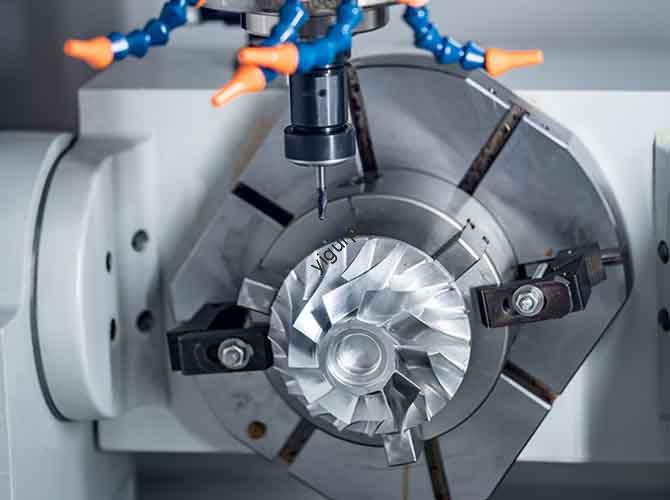In der heutigen schnelllebigen Fertigungswelt, Wie produzieren Fabriken komplexe Teile mit konsistenter Genauigkeit und Effizienz?? Die Antwort liegt in Automatische CNC -Bearbeitung—a technology that has revolutionized how we create components for industries from aerospace to medical devices. This guide breaks down everything you need to know about this game-changing process, from its basic structure to real-world applications.
1. What Is Automatic CNC Machining?
Im Kern, Automatische CNC -Bearbeitung Verwendet Computer Numerical Control (CNC) systems to automate machine tool movements, eliminating the need for constant manual adjustment. Im Gegensatz zu herkömmlicher manueller Bearbeitung, which relies on human skill to guide tools, CNC machining follows preprogrammed instructions to deliver repeatable, Hochwertige Ergebnisse.
Key Components of an Automatic CNC Machining System
The system cannot function without four critical parts. The table below outlines their roles:
| Komponente | Primäre Funktion |
| CNC Machine Tools | Execute physical machining tasks (Z.B., Schneiden, Bohren, Mahlen) on raw materials. |
| CNC-Steuerungssystem | Interpret program code and send signals to control tool speed, Position, und Futterrate. |
| Programming Software | Create G-code (Die Sprache der CNC -Maschinen) using 3D models (Z.B., CAD software outputs). |
| Skilled Operators | Monitor operations, troubleshoot errors, and adjust parameters for optimal performance. |
2. 3 Unbeatable Advantages of Automatic CNC Machining
Why do manufacturers worldwide choose automatic CNC machining over traditional methods? Here are three non-negotiable benefits:
- Hohe Automatisierung: Einmal programmiert, CNC machines can run 24/7 mit minimalem menschlichen Eingreifen. Zum Beispiel, a medical device factory can produce 500+ precision surgical screws in a single shift—something manual machining could never match.
- Außergewöhnliche Präzision: CNC systems operate with tolerances as tight as ±0.001 inches (0.0254 mm). This level of accuracy is critical for aerospace parts, where even a tiny error could lead to catastrophic failures.
- Strong Flexibility: Need to switch from making a aluminum bracket to a stainless steel gear? Simply update the program—no need to retool the entire machine. This cuts setup time by 50% or more compared to traditional machining.
3. The Step-by-Step Automatic CNC Machining Process
Creating a part with automatic CNC machining follows a linear, Wiederholbarer Workflow. Think of it like baking a cake: you need the right recipe (Programm) and steps to get a consistent result.
- Design Modeling: Verwenden CAD -Software (Z.B., Solidworks, Autocad) to build a 3D digital model of the part. This model acts as the “blueprint” for machining.
- Datenkonvertierung: Export the CAD model to a format CNC machines understand, wie zum Beispiel Stl (Standard -Tessellationssprache) or STEP. This step ensures the machine can “read” the design.
- Schneiden & Programmierung: Verwenden Sie CAM (Computergestützte Fertigung) software to slice the 3D model into 2D layers (like slicing a loaf of bread). The software then generates G-code—specific instructions for the machine’s tools.
- Layer-by-Layer Machining: The CNC machine follows the G-code to remove material (Z.B., via milling or turning) Schicht für Schicht, shaping the raw material into the desired part.
- Nachbearbeitung: Finish the part with tasks like sanding (Oberflächen glätten), Enttäuschung (to remove sharp edges), oder malen (für Korrosionsbeständigkeit).
4. Automatic CNC Machining vs. Traditionelle Bearbeitung: A Clear Comparison
Is automatic CNC machining worth the investment? Let’s compare it to traditional manual machining using key metrics:
| Metrisch | Automatic CNC Machining | Traditionelle manuelle Bearbeitung |
| Genauigkeit | Tolerances of ±0.001–±0.005 inches | Tolerances of ±0.01–±0.05 inches (hängt von Bedienerkenntnissen ab) |
| Produktionsgeschwindigkeit | 2–5x faster for high-volume runs | Langsam; limited by human reaction time |
| Labor Requirement | 1 operator can monitor 3–5 machines | 1 operator per machine |
| Kosten für komplexe Teile | Untere (no retooling for design changes) | Höher (requires custom tools for each part) |
5. Yigu Technology’s Perspective on Automatic CNC Machining
Bei Yigu Technology, Wir sehen Automatische CNC -Bearbeitung as the backbone of modern manufacturing innovation. Im letzten Jahrzehnt, Wir haben geholfen 200+ clients—from automotive startups to medical device makers—adopt CNC solutions that cut production costs by 30% und verbessern die Teilqualität durch 40%.
The biggest pain point we solve? Small-batch production inefficiencies. Many manufacturers worry CNC is only for large runs, but our tailored programs let clients produce 10–500 parts cost-effectively. Als technologische Fortschritte (Z.B., AI-powered CNC systems), we’ll keep making this tool more accessible to drive industry growth.
FAQ: Your Top Automatic CNC Machining Questions Answered
Q1: What materials can be used in automatic CNC machining?
A1: Almost any rigid material works, einschließlich Aluminium, Stahl, Titan, Plastik (Z.B., ABS), Holz, and even some ceramics. The choice depends on the part’s use (Z.B., Titan für hochfeste Luft- und Raumfahrtteile).
Q2: How long does it take to program a CNC machine for a new part?
A2: Für einfache Teile (Z.B., eine einfache Halterung), programming takes 1–2 hours. Für komplexe Teile (Z.B., a medical implant with curved surfaces), it may take 4–8 hours—still faster than creating custom tools for traditional machining.
Q3: Ist eine automatische CNC -Bearbeitung für kleine Unternehmen geeignet?
A3: Ja! Viele CNC -Anbieter (Wie Yigu -Technologie) Bieten Sie skalierbare Lösungen an. Kleine Unternehmen können mit einer einzigen Maschine und kurzfristigen Programmen beginnen, Vermeiden Sie große Vorabinvestitionen und genießen gleichzeitig die Genauigkeit und Geschwindigkeit von CNC.
